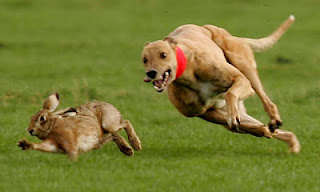Hares and jackrabbits are leporids belonging to the genus Lepus. A hare less than one year old is called a leveret. Four species commonly known as types of hare are classified outside of Lepus: the hispid hare (Caprolagus hispidus), and three species known as red rock hares (Pronolagus spp.). Hares are very fast-moving.
The European brown hare (Lepus europaeus) can run at speeds of up to 72 km/h (45 mph). They live solitarily or in pairs, while a "drove" is the collective noun for a group of hares. A common type of hare in Arctic North America is the snowshoe hare, replaced farther south by the black-tailed jackrabbit, white-tailed jackrabbit, and other species.
Normally a shy animal, the European brown hare changes its behavior in spring, when hares can be seen in broad daylight chasing one another around meadows; this appears to be competition between males to attain dominance (and hence more access to breeding females). During this spring frenzy, hares can be seen "boxing"; one hare striking another with its paws (probably the origin of the term "mad as a March hare").
For a long time it had been thought that this was inter-male competition, but closer observation has revealed that it is usually a female hitting a male to prevent copulation. They are hence able to fend for themselves soon after birth; they are precocial. By contrast, the related rabbits and cottontail rabbits are altricial, having young that are born blind and hairless.
All rabbits (except the cottontail rabbits) live underground in burrows or warrens, while hares (and cottontail rabbits) live in simple nests above the ground, and usually do not live in groups. Hares are generally larger than rabbits, with longer ears, and have black markings on their fur. Hares have not been domesticated, while rabbits are kept as house pets.



